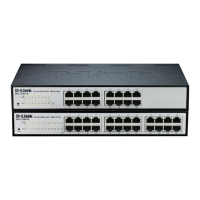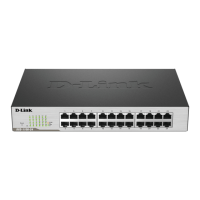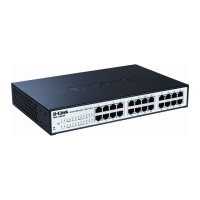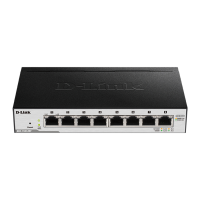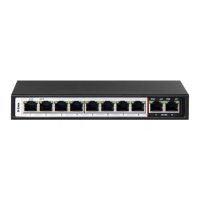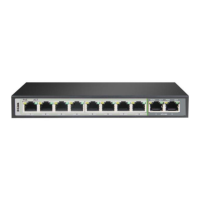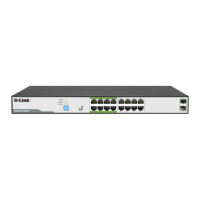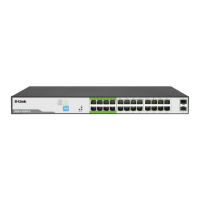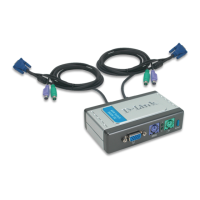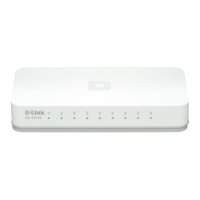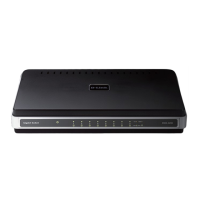Do you have a question about the D-Link EasySmart DES-1100-24 and is the answer not in the manual?
Defines key terms and conventions used throughout the manual.
Legal information regarding copyright, trademarks, and disclaimers.
Details and diagrams of the DES-1100-16 model's front and rear panels.
Details and diagrams of the DES-1100-24 model's front and rear panels.
Instructions for unpacking the switch and verifying all included items.
Recommendations for safe switch installation, including placement and ventilation.
Instructions for using rubber feet for desktop placement and ensuring adequate airflow.
Steps to mount the switch in a rack using mounting brackets.
Initial safety notes for installing the switch in a rack.
Comprehensive safety instructions specific to rack-mounted equipment.
Instructions for connecting power and actions during power failure.
Step-by-step guide for connecting the switch to a protective ground.
Introduces Web-based Management and SmartConsole Utility.
Steps to configure the switch using a web browser.
Lists compatible web browsers for management.
Equipment needed and steps to establish a connection for configuration.
How to log in and access the switch's web interface.
Overview of the SmartConsole Utility for managing switches.
Detailed instructions for installing the SmartConsole Utility via CD.
Description of the main components: Device Configurations, Device List, and Settings.
How to configure refresh times and discovery intervals in the utility.
How to view and clear system and device logs within the utility.
How to view and clear trap messages received by the utility.
Options for saving and loading device list settings.
Accessing the utility's help window for version and copyright details.
Configuring IP address, system name, and other device-specific parameters.
How to set or change the device password for authentication.
Displays an error message when firmware upgrade is not supported.
How to refresh the IP address from a DHCP server for a client-enabled switch.
Accessing web management and adding/removing devices.
Procedures for adding or removing devices from the discovered list.
Explains the columns and indicators in the device list.
Detailed definitions for each field in the Device List, including Gateway and Firmware version.
Introduction to the web-based management interface structure and login.
Explains the Save Menu for configuration backup and the Tool Menu for system operations.
How to reset the system to factory defaults or reboot the device.
Instructions for upgrading the switch firmware using a saved file.
Procedures for backing up and restoring switch configuration settings.
How to navigate configuration options using the function tree.
Overview of switch information like firmware, hardware, and IP address.
Status of features like Port Mirroring, Storm Control, and VLANs.
Explains static vs. DHCP IP addressing for the switch.
How to set system name, location, and login timeout.
How to monitor and adjust port speed, link status, and flow control.
Configuring trap settings to monitor events via SmartConsole.
Procedure for setting or changing the switch's password.
How to group multiple ports for increased bandwidth.
Enabling IGMP snooping for intelligent multicast forwarding.
Configuring port mirroring to monitor network traffic.
Enabling and configuring loopback detection to prevent network loops.
Overview of available statistics counters for port traffic.
Viewing packet counts for successful reception and transmission.
Monitoring transmit collisions and received dropped packets per port.
Monitoring received packets and CRC error counts per port.
Introduction to VLANs and the 802.1Q standard for network segmentation.
Steps to create, rename, and delete VLAN groups and assign ports.
Setting up a management VLAN for enhanced network flexibility.
Assigning appliance LAN ports to VLANs for network segmentation.
Configuring Quality of Service priority levels for network traffic.
Controlling broadcast, multicast, and unknown unicast packet storms.
Defining bandwidth limits for port transmission and reception rates.
Disabling auto-learning and manually adding static MAC addresses for security.
Displays learned MAC addresses per port for network management.
Functionality to add learned MAC addresses to the static list.
Explanation of Gigabit Ethernet features and benefits.
Details on 100Mbps Fast Ethernet and its advantages.
Overview of how switching technology enhances network capacity.
Details on switching capacity, forwarding rate, buffer, and flash memory.
Compliance with IEEE standards and duplex operations.
Operating temperature, humidity, and power input specifications.
FCC, CE, VCCI, cUL, and LVD certifications.
Summary of L2 features, VLAN support, QoS, and management options.
Safety guidelines for installing equipment in a rack environment.
| Standards | IEEE 802.3, IEEE 802.3u, IEEE 802.3x |
|---|---|
| Switching Capacity | 4.8 Gbps |
| MAC Address Table | 8K entries |
| Forwarding Rate | 3.57 Mpps |
| Dimensions | 440 x 180 x 44 mm |
| Jumbo Frame Support | Up to 9K bytes |
| Humidity | 10% to 90% non-condensing |
| Ports | 24 x 10/100 Mbps |
| Operating Temperature | 0°C to 40°C |
| Power Supply | 100-240V AC, 50/60Hz |
| Storage Temperature | -40°C to 70°C |
